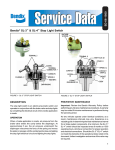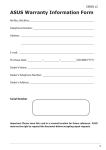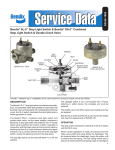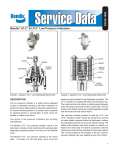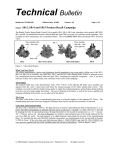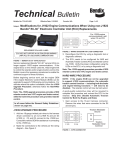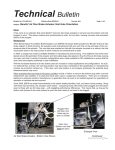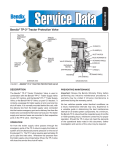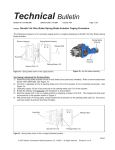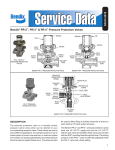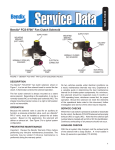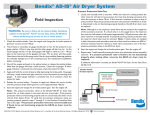Download BENDIX SD-06-1800 User's Manual
Transcript
SD-06-1800 Bendix® SL-3™ & SL-4™ Stop Light Switch 7 MACHINE SCREWS 2 TERMINAL SCREWS 4 PLUNGER BODY 9 TERMINAL SCREWS 1 COVER 7 TERMINAL CONNECTOR CONTACTS 3 SPRING 5 WASHER 6 DIAPHRAGM 10 VENT PLUG 8 COVER 11 SPRING CONTACT 13 PISTON 14 O-RING DIAPHRAGM 12 CONTACT STRIP 15 GASKET BODY FIGURE 1 - BENDIX® SL-3™ STOP LIGHT SWITCH FIGURE 2 - BENDIX® SL-4™ STOP LIGHT SWITCH DESCRIPTION PREVENTIVE MAINTENANCE The stop light switch is an electro-pneumatic switch and operates in conjunction with the brake valve and stop lights by completing the electrical circuit when a brake application is made. Important: Review the Bendix Warranty Policy before performing any intrusive maintenance procedures. A warranty may be voided if intrusive maintenance is performed during the warranty period. OPERATION No two vehicles operate under identical conditions; as a result, maintenance intervals may vary. Experience is a valuable guide in determining the best maintenance interval for air brake system components. At a minimum, the Bendix® SL-3™ and SL-4™ switches should be inspected every 6 months or 1500 operating hours, whichever comes first, for proper operation and electrical connections. Should the SL-3™ or SL-4™ switch not meet the elements of the operational tests noted in this document, further investigation and service of the valve may be required. When a brake application is made, air pressure from the brake valve enters the cavity below the diaphragm. At approximately 5 psi, the air pressure underneath the diaphragm overcomes the force of the spring and moves the piston or plunger until the contact points close, completing the stop light electrical circuit and lighting the stop lights. 1 TESTING FOR SERVICEABILITY CLEANING AND INSPECTION OPERATING TEST Clean all metal parts in cleaning solvent. Wipe rubber parts dry with a cloth. 1. Apply the brake valve and note that the stop light lights before the delivery pressure reaches 7 psi. 2. Release the brake valve and note that the stop light goes “off”. LEAKAGE TEST 1. With the brakes fully applied, no leakage is permitted at the stop light switch. If the stop light switch does not function as described or if leakage is excessive, it is recommended that it be replaced with a new unit or repaired with genuine Bendix® brand replacement parts available at authorized Bendix parts outlets. Inspect contact points for pits or wear. If pitting is not too severe, the points may be reconditioned by filing with a distributor point file. If points cannot be reconditioned, they should be replaced. The contact strip in the SL-4™ switch may be turned over to use the other side of the contacts. Check the spring for signs of deterioration; Replace if discolored. The spring in the SL-3™ switch carries the current of the electrical circuit involved; consequently, in the case of excessive current, as might be caused by a short, the spring will be overheated and ruined. REMOVING Inspect cover and body. If cracked or damaged, replace. 1. Disconnect the electrical connections at the stop light switch. Only genuine Bendix service parts should be used for replacement. 2. Disconnect the air line to the stop light switch. ASSEMBLY 3. Remove the stop light switch. INSTALLING SL-3™ SWITCH (Figure 1) 1. Install in a convenient location for servicing. 1. Insert terminal screws (2) in the cover (1), making sure the terminal connector (7) is properly positioned. 2. Install with the pipe tap pointing to the ground and keep it high for adequate drainage. 2. Secure terminal screws with washers and nuts, or terminal clips, as the case may be. 3. Connect the stop light switch in series in the stop light circuit. 3. Place diaphragm (6) in the body. 4. Keep the stop light switch terminals away from frame members to avoid grounding. 5. Position spring (3) on the plunger. 5. Connect the pipe tap to the brake chamber supply line so that the stop light switch will operate whether the foot or hand valve is applied. DISASSEMBLY ® ™ BENDIX SL-3 SWITCH 1. Place hex portion of body in a vise. 2. Using a large end wrench on cover flats, turn cover (1) in a counterclockwise direction and remove from body. 3. Remove terminal nuts, terminal screws (2) and terminal connector (7) from cover. 4. Remove spring (3), plunger (4), washer (5) and diaphragm (6) from body. BENDIX® SL-4™ SWITCH 1. Remove two machine screws (7) and remove cover (8). 2. Remove the terminal nuts and terminals (9) from cover. 3. Remove the vent plug (10) from cover. 4. Remove spring (11), contact strip (12), piston (13) and o-ring diaphragm (14) from body. 2 4. Position the contact plunger (4) on diaphragm. 6. Place washer (5) on the diaphragm and screw the cover (1) into the body. Torque to 30 foot pounds. Make certain the vent hole in the cover is open. SL-4™ SWITCH (Figure 2) 1. Position terminal screws (9) in the cover (8) and secure with washers and nuts or terminal clips. Place the vent plug (10) in cover. 2. Place o-ring diaphragm (14) and piston (13) in the body. The o-ring diaphragm should be installed with its flat side adjacent to the piston. 3. Place the gasket (15) in place on the body and contact strip (12) on the piston (13). 4. Position cover assembly on the gasket and secure with machine screws. Torque to 20 inch pounds. TEST OF REBUILT STOP LIGHT SWITCH Both operating and leakage tests, as indicated under section entitiled “Testing for Serviceability”, must be made after rebuilding or repairing the stop light switch. The switch must meet the following specifications: 1. No leakage is permissible at the stop light switch with the brakes applied. 2. The stop light switch contact should close with not more than 7 pounds of air pressure. 3 4 BW1593 © 2011 Bendix Commercial Vehicle Systems LLC, a member of the Knorr-Bremse Group • 6/2011 • All rights reserved




